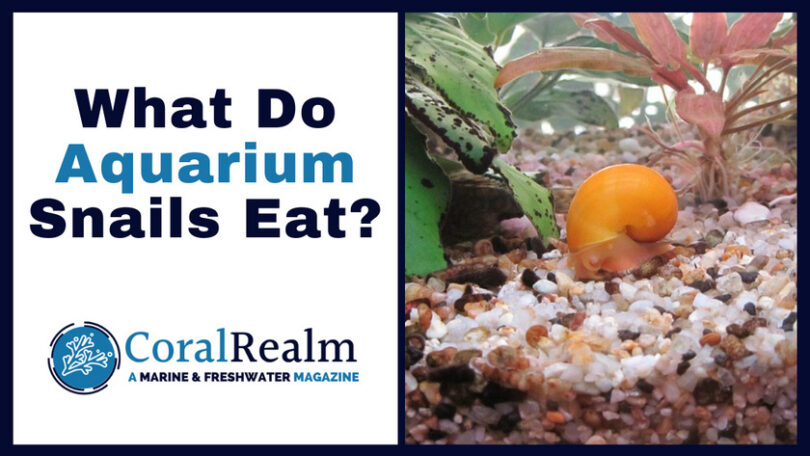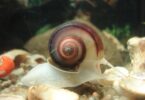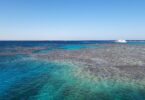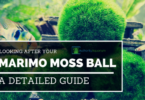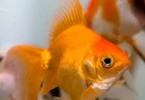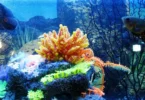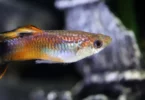Last Updated on February 10, 2023 by Matt
Aquarium snails really are a great addition to any fish tank, as they help keep algae and plants in check. It’s great to mix aquatic life together and they are kind of beautiful in some ways. But what exactly do aquarium snails eat? You might be surprised to learn that these slimy mollusks are omnivores. Aquarium snails eat both plant material and animal matter. Their diet will typically depend on their environment; for example, whether or not they live in the presence of other animals. Aquarium snails love plants because they’re packed with nutrients; however, some plants aren’t safe for them to eat. Luckily, there are plenty of plants that are perfect for your snail’s diet! Keep reading to learn more!
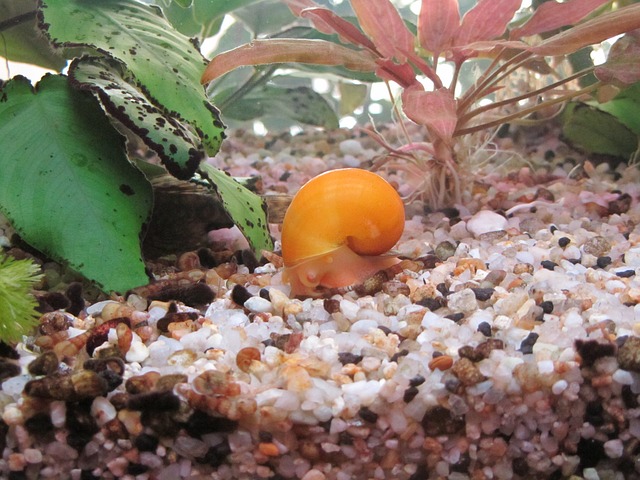 In the wild, they typically eat algae, decaying plant matter, and small invertebrates. In captivity, they can be fed a variety of foods, including blanched vegetables, pellets, flakes, and live or frozen foods. If you do want to offer extra food (usually to prevent eating plants), it is important to offer them a varied diet to ensure that they are getting all the nutrients they need.
In the wild, they typically eat algae, decaying plant matter, and small invertebrates. In captivity, they can be fed a variety of foods, including blanched vegetables, pellets, flakes, and live or frozen foods. If you do want to offer extra food (usually to prevent eating plants), it is important to offer them a varied diet to ensure that they are getting all the nutrients they need.
Aquarium snails are indeed diverse creatures, and snails throughout various ecosystems have learned to survive. Fresh, salt, brackish and even deep ocean snails exist, and they’re hardy in the aquarium environments too; often hitching a ride on plants and other aquarium industry decor. That means some will get into your tank without your permish!
Aquarium snails are not particularly picky eaters, but there are a few things to keep in mind when feeding them. First, make sure that the food you offer is small enough for them to eat. Second, some aquarium snails are known to nibble on live plants, so if you have live plants in your tank, you may want to avoid feeding them to your snails. Finally, be aware that some aquarium snail species are carnivorous and will need a diet that includes meaty foods. Aquarium snails are scavengers and will consume just about anything they come across. This includes leftover fish food, algae, dead plants, and even other small invertebrates. In fact, it’s not uncommon for snail populations to explode in tanks where there is an abundance of food.
IN THIS ARTICLE
What exactly do aquarium snails eat?
The list of what aquarium snails eat is simple:
- Algae
- Dead plant matter
- Old fish food
- Living plants
- Human-given food such as:
- Lettuce
- Kale
- Zucchini
In addition to consuming algae, dead plant material, bits of fish food, bloodworms, brine shrimps, fruits, blanched vegetables like lettuce, kale, and zucchini, aquarium snails eat a wide range of foods. Their species, natural habitat, size, age, and individual dietary needs all determine what snails eat.
When it comes to feeding aquarium snails, the best approach is to offer them a variety of foods and let them choose what they want to eat. Test and see what your snails fancy! Some good food options for aquarium snails include algae wafers, blanched vegetables, and high-quality pellets or flakes designed for bottom-feeding fish. You can also offer them live or frozen foods, such as brine shrimp, bloodworms, or daphnia. Just be sure to offer only what they can eat in a single sitting and remove any uneaten food so that it doesn’t dirty up the water.
While most aquarium snails are not particular about what they eat, there are a few species that have more specialized diets. For example, the apple snail (scientifically: Pomacea diffusa) is a voracious eater of aquatic plants. If there are not enough plants in the tank, they will start to consume other things like fish food and detritus.
As a general rule of thumb, you should provide your snails with a variety of foods. This can be accomplished by feeding them high-quality pellets or flakes designed for bottom-dwelling fish, as well as offering them blanched vegetables and algae wafers on occasion.
If you notice your snail population starting to get out of control, you can take measures to reduce their food intake. This includes things like using an aquarium vacuum to remove uneaten food and waste from the substrate, and cutting back on how often you feed them. Too much waste is never good for a tank and can build up nitrate levels and cause nitrate poisoning.
Safe Plants for Snails
The following plants are perfect for aquarium snails. We might think encouraging our snails to eat plants is a bad idea but with algae in the tank, old bits of fish food and even fish waste in the tank they’ll hardly focus on the plants. And rarely will consume plants regularly. However, some plants have a particular affinity with the snails and they can eat too much of the following:
Duckweed:
Duckweed is a super easy to grow aquatic plant that your aquarium snails will absolutely love. Plus, it’s great for removing excess nitrates from your fish tank water.
Hornwort:
Hornwort is another easy-to-grow aquatic plant that aquarium snails will relish. It can also be used to remove excess nitrates from your fish tank water and reducing ammonia poisoning in fish.
Water Hyacinth:
Commonly used in ponds and aquariums, water hyacinth makes for a great feeding ground for aquarium snails. Plus, it can help with water flow.
Amazon Sword:
Amazon swords are a great source of fiber and protein for your aquarium snails. Plus, these plants are easy to grow and work well in most aquariums.
Water Lettuce:
Water lettuce is a fast-growing aquatic plant that aquarium snails will love. One example is dwarf water lettuce; which also works well for water flow.
Bad Foods for Aquarium Snails
Conversely, some foods are not as good for aquarium snails. These plants can be toxic to snails and the tank. But you’d think it obvious, not always as people have genuinely tried to put these into tanks before. Sad.
Many common houseplants are toxic to aquarium snails. These include African violets, begonias, ferns, ivy, philodendron, and peace lilies. – Some aquatic plants are toxic to aquarium snails as well, including java moss, java fern, and hornwort. Finally, aquarium snails should avoid eating fish food, and is another reason to limit how much you should feed fish at once.
What Do Baby aquarium Snails Eat?
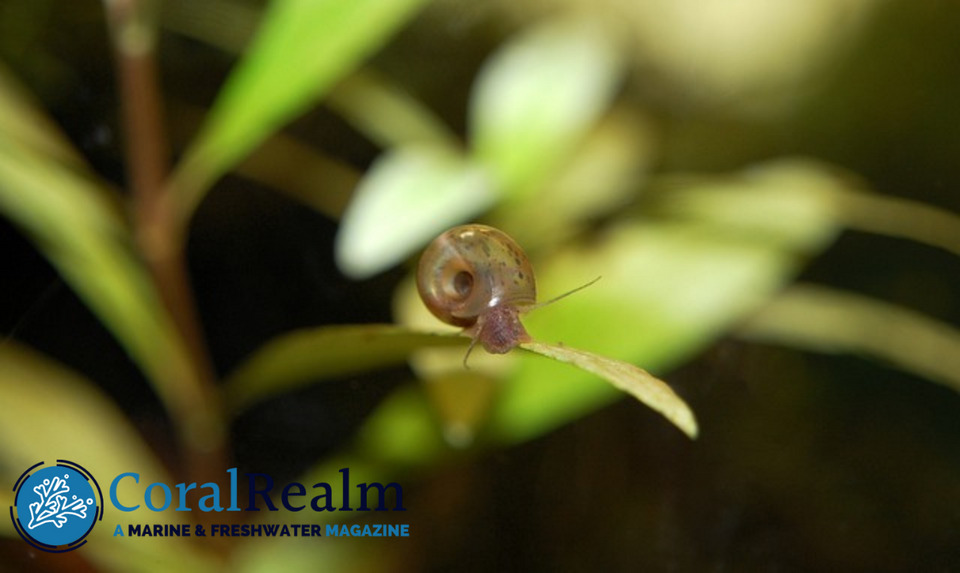
Baby aquarium snails are not able to eat the same things as adult snails initially. After some time, baby snails eat the same food that adult snails consume. They need a diet that is high in calcium so they can grow their shells properly. Some good foods for baby snails include:
-Crushed up eggshells
-Powdered calcium supplements
-Blanched vegetables like zucchini or spinach
If you are unsure if your baby snail is getting enough calcium, you can always ask your veterinarian for advice.
How Often Should aquarium Snails Be Fed?
Assuming you have a healthy population of aquarium snails, you should aim to feed them once a week. This can be done by providing them with fresh vegetables, fruits, or specially formulated snail food pellets. It is important to remove any uneaten food from the tank after a few hours, as it can decompose and pollute the water. If you notice that your snails are not getting enough food, you may need to increase the frequency of feeding. On the other hand, if you see an excessive amount of snail waste in the tank, it is likely that they are being overfed. Make sure you have good aquarium biological filtration in place to prevent toxic water buildup. In this case, cut back on their food supply accordingly.
Providing your aquarium snails with a varied diet is the best way to ensure they remain healthy and active. In addition to giving them fresh vegetables and fruits, you can also offer them blanched lettuce, cooked beans, or boiled peas. You can even offer them commercial snail food pellets from time to time as a treat. Just be sure to remove any uneaten food from the tank promptly, as it can decompose and pollute the water causing cloudy aquarium water.
Related Questions:
What do wild ocean snails eat/what do sea snails eat?
Most sea snails are herbivores and feed on ocean algae. Some species are known to be carnivorous and feed on small invertebrates, such as other snails. A few species of sea snails are known to be omnivorous and will consume both plant and animal material.
In the ocean, algae provide an important food source for many organisms; not just snails. Sea snails are no exception and graze on algae found on rocks, coral, and other hard surfaces. Many sea snails have a specialized radula (tongue) that they use to scrape algae off of surfaces. Some species of ocean snails will even bore into the shells of other snails to feed on the soft tissue inside.
While most sea snails are most content to graze on algae and other plant-based food sources, some species have evolved to become predators. These carnivorous sea snails typically prey on small invertebrates, such as worms, shrimp, and other small shellfish. These predators will use their radula to drill holes into the shells of their prey. Once the hole is drilled, the carnivorous snail will inject a poisonous toxin that paralyzes the other animal. Nasty! The snail can then safely consume the soft tissue inside the shell. Yes! Some sea snails are even known to eat other sea snails!
What do pond snails eat?
Pond snails are one of the many types of freshwater snails. They are found in ponds, lakes, rivers and streams all over the world. Pond snails are scavengers and will eat just about anything they can find. This includes dead plants, algae, and even other small creatures. Ponds tend to have a large number of floating plants, and snails often congregate here sometimes making them victims to attentive garden birds. While pond snails are not considered to be a nuisance, they can sometimes become a problem if their populations get too large. In such cases, they may compete with other animals for food or space.
What do Nerite snails eat?
Nerite snails are peaceful creatures that make great additions to any aquarium. Along with their beautiful shells, they are known for their algae-eating abilities and will help keep your tank clean.
These snails are not fussy eaters and will graze on most types of algae. They are especially fond of green algae, but will also consume diatoms, film algae, and detritus. In a well-established aquarium with plenty of algae, nerite snails can do a great job of keeping things tidy. However, if there is not enough algae to go around, they may start nibbling on soft-leaved plants. If you see your nerite snail eating plants, simply provide more blanched veggies like spinach, cucumber, lettuce, or zucchini for them to graze on or remove the snail from the tank.
In addition to algae, nerite snails will also consume leftover fish food and detritus. This helps keep the tank clean and reduces the risk of ammonia spikes and other water quality issues.
Overall, nerite snails are great additions to most aquariums. They are beautiful, helpful creatures that are not difficult to care for. If you are looking for a snail that can help keep your tank clean, a nerite snail is a good choice.
What do mystery snails eat?
Mystery snails are a type of freshwater snail that is popular in fish tanks.
So, what do mystery snails eat? In the wild, mystery snails are scavengers and will eat just about anything they can find. This includes dead plants, algae, and even other small creatures. In a fish tank, mystery snails should be given a variety of food options to keep them healthy. This can include live plants, algae wafers, and frozen or freeze-dried foods designed for aquarium use. It is important to offer mystery snails a varied diet as they are known to be picky eaters and may not consume all of the food items you offer them.
While mystery snails are not known to be aggressive, they may sometimes nip at the fins of fish that bother them. For this reason, it is generally best to keep mystery snails with peaceful fish species that will not harass them. If you do notice your mystery snail nipping at the fins of other fish, it is a good idea to remove the snail from the tank and provide it with its own separate habitat.
Overall, mystery snails are relatively low-maintenance creatures that can make a great addition to any freshwater fish tank. As long as you provide them with a varied diet and a safe place to live, they will likely thrive in your aquarium for years to come.
Summary
Freshwater aquarium snails are a common sight in many tanks. While some people view them as pests, others appreciate the benefits they can bring to an ecosystem.
Aquarium snails are a great addition to any fish tank, as they help keep algae and plants in check. They’re also a great way to introduce children to caring for aquatic life. These slimy mollusks are omnivores and love plants because they’re packed with nutrients. There are plenty of plants that are safe for snails to eat, and you can feed them by introducing fresh vegetables and fruits into your fish tank.
In conclusion, what do freshwater aquarium snails eat: A variety of things! By offering them a variety of foods, you can ensure they are getting all the nutrients they need to stay healthy and happy. If you notice your snail population starting to get out of control, take easy and pro-active measures to reduce their food.

